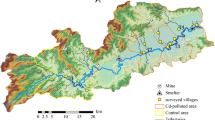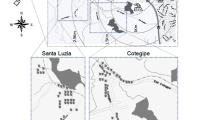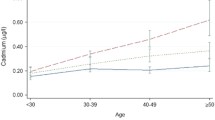Abstract
Urinary cadmium (UCd) is a good indicator of long-term exposure to cadmium. UCd concentrations resulting from juvenile cadmium exposure in 3 sub-districts of Tak Province, Thailand, were investigated. The target population was divided by gender and into 2 age subgroups: 9–12 and 13–15 years. A total of 748 urine samples were collected and analyzed by spectrophotometer. All samples had UCd of more than 1.0 μg/g creatinine (Cr). Total UCd means among the 3 sub-districts were 1.31, 1.01, and 0.87 μg/g Cr; the Thai population mean is 0.5 μg/g. The difference among the three sub-districts was statistically significant (p < 0.05). Total means for UCd were 1.13 μg/g Cr for boys, 1.00 for girls, 1.01 μg/g Cr for those 9–12 years old, and 1.18 for those 13–15. UCd concentrations were not significantly different between genders and age groups. Likely dietary sources of cadmium exposure for the subject population were surveyed.

Similar content being viewed by others
References
Alloway, B. J., & Ayres, D. C. (1993). Chemical principles of environmental pollution. Glasgow: Blackie Academic & Professional.
Apinan, R., Satarug, S., Ruengweerayut, R., Mahavorasirikul, W., & Na-Bangchang, K. (2010). The influence of iron stores on cadmium body burden in a Thai population. Environmental Geochemistry and Health, 32, 237–242.
Berglund, M., Akesson, A., Nermell, B., & Vahter, M. (1994). Intestinal absorption of dietary cadmium in women depends on body iron stores and fiber intake. Environmental Health Perspectives, 102, 1058–1066.
Błach-Legawiec, I., Emich-Widera, E., Bibrzycka, A., Marszał, E., & Woś, H. (2002). Concentrations of cadmium in blood and urine and their contents in the hair of children from Katowice Murcki. Wiadomosci Lekarskie, 55(1), 633–638.
Bressler, J. P., Olivi, L., Cheong, J. H., Kim, Y., Bannona, D. (2004). Divalent metal transporter 1 in lead and cadmium transport. Annals of the New York Academy of Sciences, 1012, 142–152.
Chaiwong, T. (2009). The effect of a health belief model-based teaching program on prevention of cadmium intake among at-risk female students. M.S. Thesis, Phitsanulok Graduate School, Thailand.
Chanthachot, W., Busamongkol, A., Khuntong, S., Peripart, R., Loaharojanapanal, S. (2005). Analysis of heavy metals in soil along Mae Tao River, Tak Province, by nuclear technique. In 31st Congress on Science and Technology of Thailand at Suranaree University of Technology, 18–20 October.
Hellström, L., Persson, B., Brudin, L., Petersson, G. K., Öborn, I., & Järup, L. (2007). Cadmium exposure pathways in a population living near a battery plant. Science of the Total Environment, 15, 447–455.
Hofmann, T., & Schuwirth, N. (2008). Zn and Pb release of sphalerite (ZnS)-bearing mine waste tailings. Journal of Soils and Sediments, 8, 433–441.
Juwa, S. (2008). Environmental impact and health risk assessment from foods consumption in cadmium contaminated areas Mae Sot District, Tak Province. Ph.D. Dissertation, Naresuan University, Phitsanulok, Thailand.
Liu, H., Probst, A., & Liao, B. (2005). Metal contamination of soils and crops affected by the Chenzhou lead/zinc mine spill (Hunan, China). Science of the Total Environment, 339, 153–166.
Moon, C. S., Zhang, Z. W., Shimbo, S., Watanabe, T., Lee, C. U., Lee, B. K., et al. (1999). Evaluation of urinary cadmium and lead as markers of background exposure of middle-age women in Korea: Dietary intake as an influential factor. Toxicology Letters, 108, 173–178.
Munkhuamdee, D. (2007). Guide. Bangkok: Bureau of Laboratory Personnel Development Analytical AAS.
NFA. (2002). Risk report: Chemical hazards of food and drinking water. National Food Agency, Valvontaopas-sarja 2/2002, Helsinki.
Noonan, C. W., Sarasua, S. M., Campagna, D., Kathman, S. J., Lybarger, J. A., & Mueller, P. W. (2002). Effects of exposure to low levels of environmental cadmium on renal biomarkers. Environmental Health Perspectives, 110, 151–155.
O’Neill, P. (1993). Environmental chemistry (2nd ed.). London: Chapman & Hall.
Padungtod, C., Swaddiwudhipong, W., Nishijo, M., Ruangyuttikarn, W., Inud, T. (2006). Health risk management for cadmium contamination in Thailand. Intergovernmental Forum on Chemistry Safety. 25–29 September, Budapest.
Paschal, D. C., Burt, V., Caudill, S. P., Gunter, E. W., Pirkle, J., Sampson, E. J., et al. (2000). Exposure of the U.S. population aged 6 years and older to cadmium: 1988–1994. Archives of Environmental Contamination and Toxicology, 38, 377–383.
Phaenark, C., Pokethitiyook, P., Kruatrachue, M., & Ngernsansaruay, C. (2009). Cd and Zn accumulation in plants from the Padaeng zinc mine area. International Journal of Phytoremediation, 11, 479–495.
Reeves, P. G., & Chaney, R. L. (2002). Nutritional status affects the absorption and whole-body and organ retention of cadmium in rats fed rice-based diets. Environmental Science and Technology, 36, 2684–2692.
Reeves, P. G., & Chaney, R. L. (2004). Marginal intakes of zinc, iron, and calcium enhance the accumulation of cadmium in the intestine of rats fed a rice-based diet. Environmental Research, 96, 311–322.
Ripley, E. A., Redmann, R. E., & Crowder, A. A. (1996). Environmental effects of mining. FL: St. Lucie Press.
Satarug, S., Baker, J. R., Urbenjapol, S., Haswell-Elkins, M., Reilly, P. E., & Williams, D. J. (2003). A global perspective on cadmium pollution and toxicity in non-occupationally exposed populations. Toxicology Letters, 137, 1–2.
Satarug, S., Haswell-Elkins, M. R., & Moore, M. R. (2000). Safe levels of cadmium intake to prevent renal toxicity in human subjects. British Journal of Nutrition, 84, 791–802.
Satarug, S., & Moore, M. R. (2004). Adverse health effects of chronic exposure to low-level cadmium in foodstuffs and cigarette smoke. Environmental Health Perspectives, 112, 1099–1103.
Simmons, R. W., Pongsakul, P., Saiyasitpanich, D., & Klinphoklap, S. (2005). Elevated levels of cadmium and zinc in paddy soils and elevated levels of cadmium in rice grain downstream of a zinc mineralized area in Thailand: implications for public health. Environmental Geochemistry and Health, 27, 501–511. doi:10.1007/s10653-005-7857-z.
Swaddiwudhipong, W., Limpatanachote, P., Mahasakpan, P., Krintratun, S., & Padungtod, C. (2007). Cadmium-exposed population in Mae Sot District, Tak Province: 1. Prevalence of high urinary cadmium levels in the adults. Journal of the Medical Technologist Association of Thailand, 90, 143–148.
Teeyakasem, W., Nishijo, M., Honda, R., Satarug, S., Swaddiwudhipong, W., & Ruangyuttikarn, W. (2007). Monitoring of cadmium toxicity in a Thai population with high-level environmental exposure. Toxicology Letters, 169, 185–195.
Thai Association of Toxicology. (2007). Risk evaluation and health risk assessment: case studies. 24th Annual Meeting, 22–23 November, Bangkok.
U.S. Agency for Healthcare Research and Quality. (1996). Screening for iron deficiency anemia in childhood and pregnancy. Oregon Evidence-based Practice Center.
Usha, M., Venugopal, V. K., & Saraswathy, P. (2002). Cadmium content of plants as affected by Soil application of cadmium and farm yard manure. Journal of Tropical Agriculture, 40, 78–80.
WHO. (2000). Air quality guidelines (2nd ed.). Copenhagen: WHO Regional Office for Europe.
World Health Organization. (2006). Evaluation of certain food contaminants : sixty-fourth report of the Joint FAO/WHO Expert Committee on Food Additives. WHO Press Geneva 27, Switzerland.
Wright, J. (2003). Environmental Chemistry. New York, NY: Routledge.
Zarcinas, B., Ishak, C., McLaughlin, M., & Gill, C. (2004). Heavy metals in soils and crops in Southeast Asia: Peninsular Malaysia. Environmental Geochemistry and Health, 26, 343–357.
Acknowledgments
The researchers would like to express their gratitude to The National Research Council of Thailand for financial support of specimen collection, and to the Anamai Department, Ministry of Health, for sample analysis. Dennis McDermott PhD assisted with language editing.
Author information
Authors and Affiliations
Corresponding author
Electronic supplementary material
Below is the link to the electronic supplementary material.
Rights and permissions
About this article
Cite this article
Chaiwonga, S., Sthiannopkao, S., Supanpaiboon, W. et al. Urinary cadmium concentrations in a population downstream: from a zinc mining area in Mae Sot District, Tak Province, Thailand. Environ Geochem Health 35, 69–78 (2013). https://doi.org/10.1007/s10653-012-9466-y
Received:
Accepted:
Published:
Issue Date:
DOI: https://doi.org/10.1007/s10653-012-9466-y




